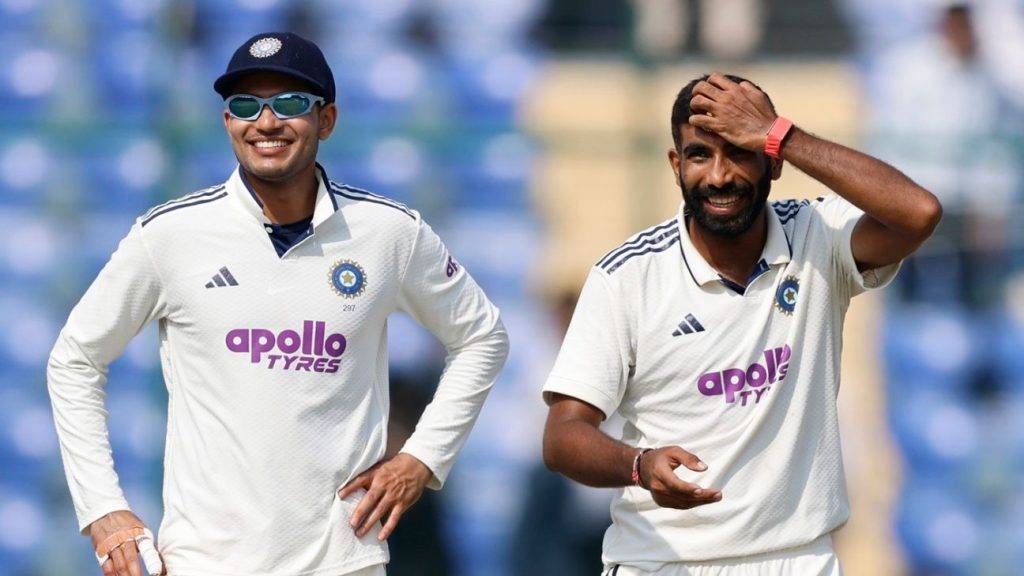Cliff Notes – Heartening to take 20 wickets on this Delhi surface
- India’s strategy has evolved from using spin-friendly pitches to seeking balanced surfaces that allow for high first-innings scores, as demonstrated in their recent Test series against the West Indies.
- Despite a dominant first Test victory, India’s bowlers faced a grueling challenge in Delhi, bowling nearly 200 overs to secure a series lead, highlighting the difficulties of the pitch.
Washington: Heartening to take 20 wickets on this Delhi surface
If the Chennai defeat to England in 2021 made India switch from flat home pitches that took turn in the second innings to square turners, the shock 3-0 reverse to New Zealand last year made them rethink the latter strategy.
During the ongoing two-Test series against West Indies, India have stated their desire to play on balanced pitches that give batters the chance of scoring big runs, particularly in the first innings.
The plan worked out perfectly in the first Test against West Indies in Ahmedabad, where India rushed to an innings win in three days, but it may have hit a bit of a snag in Delhi, where India are poised to take the series 2-0 going into day five, but only after their bowlers slogged for nearly 200 overs — all in one go following their decision to enforce the follow-on — to bowl West Indies out twice.
Editor’s Picks
2 Related
Could this prompt another rethink? India allrounder Washington Sundar isn’t thinking about all that; for now he’s happy to experience the variety of challenges that different venues throw up.
“It’s quite different in different venues, isn’t it?” he said in his press conference at the end of day four. “This I would say is a typical Delhi wicket, where there’s not much bounce, and obviously there wasn’t a lot of turn on offer in this game. But yeah, different venues play quite differently, and that’s the beauty of this format in particular.
Shubman Gill and Jasprit Bumrah share a light moment Associated Press
“We play in a lot of different conditions, be it home or away, and obviously all those conditions and the opposition challenge our skillsets, and that’s the beauty of this format. We keep going. We try and assess what’s really required in those conditions and really be on top of a game and do something special for the team.”
India’s spin trio of Kuldeep Yadav, Ravindra Jadeja and Washington bowled 143.5 overs across the two West Indies innings, and picked up 13 wickets between them.
“On this kind of a wicket you just need to be patient and try and hit those [good] areas more consistently, and that’s the only challenge,” Washington said. “It’s good to be bowling long spells, and it’s very heartening to have actually taken 20 wickets on a wicket like this. All of the bowlers bowled really well, even the fast bowlers bowled their heart out every single spell, so it’s very heartening.”
John Campbell and Shai Hope led West Indies’ fight in their follow-on innings, scoring centuries and putting on 177 for the third wicket. Washington praised them for settling into their partnership by taking calculated risks to spread the field.
“Honestly, Campbell and Hope played really well,” Washington said. “They took their chances, and once the field was spread out they were really sensible with their game as well.”
India, Washington felt, were well-prepared for spending long hours on the field, having played their last Test series in England, where all five Tests went into the fifth day. “The England series definitely made us understand what it actually feels like to be on the field for five days, because even in England we fielded for about 180-200 overs every game, so this definitely isn’t something very new to us.”
play
2:43
Chopra: Credit to West Indies for pushing India into day five
Aakash Chopra on the West Indies batting performance on the fourth day in Delhi
Since his return to the Test team during the New Zealand series last year, Washington has often played as one of three allrounders in India’s line-up. This has meant he’s ended up playing more of a batting-heavy role in some games and a bowling-heavy role in others; in this series, he’s only got to bat once so far in three innings, with India declaring after he had faced 13 balls in that one innings.
“It’s just been a blessing, honestly,” Washington said. “To be an allrounder is really heartening, because you’re always in the game, either with the ball or bat, and you have a great opportunity with both skillsets to make an impact for the team and eventually win the game for the team. I’ve got to thank god for all the skills he’s blessed me with.
“In Test cricket it’s better to have as many allrounders [as possible], because if you go back and see, most of the teams who have dominated Test cricket for many years, I think they’ve had good-quality allrounders in their line-up, and I’d say we’ve got some really quality allrounders in our team as well.”
While this is not necessarily true of the West Indies teams that dominated world cricket in the 1970s and 80s or the Australia team of the 2000s, it is certainly true of the India sides that won every home series they played from 2013 until the loss to New Zealand last year, with spin-bowling allrounders Jadeja, R Ashwin and later Axar Patel and Washington himself adding depth and heft to both the bowling and batting.
Starting their fourth-innings pursuit of 121 late on Monday evening, India began as if they were looking to end the game on day four itself, with Yashasvi Jaiswal hitting two fours in the first over before falling in the second while attempting a big hit down the ground. They knuckled down thereafter to ensure no other wicket fell, with KL Rahul and B Sai Sudharsan putting on an unbroken 54 to take India into day five needing a further 58 runs to win.
“A lot of you all also would have liked it if the game got over today,” Washington joked to the assembled mediapersons. “Jaiswal did his best — on another day he would have definitely finished [it] today.”


